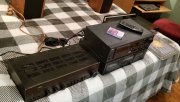Here is a start, if you don't plan to use additional equipment such as a tone generator, external meter, etc.
1) Load the selected cassette into the recorder and fast-wind the tape forward for a few seconds to get past the blank leader tape at the beginning.
2) Set the Play Trim control to "0" (the detented position at the middle of it's range).
3) Set the Tape Selector to match the type of tape.
4) Set the Dolby NR switch to "C" and switch the MPX filter on. (Even though you may be planning to make a recording with Dolby B-type NR, it is best to use Dolby C-type NR while adjusting bias because it enhances the audibility of any response errors caused by over- or under-biasing.)
5) Set the Bias fine-tuning control to 0 (i.e. to the detented position at the center of it's range), unless you have reason to prefer a different trial setting.
6) Record a brief sample of music at low recording levels (approx. -15 dB). For best results the music should have obvious high-frequency content. A convenient alternative, especially when the most accurate results are desired, is to record interstation hiss from an FM tuner (with it's muting off) at a level of about -20 dB.
7) Using the INPUT MONITOR button, compare the tonal balance of the recording versus that of the input signal.
8) If the recording sounds duller than the original sound, raise the setting of the Bias fine-adjust control (move it toward the + symbol) to obtain brighter highs.
On the other hand, if the trial recording sounds bright, edgy, or distorted, reduce the setting of the Bias fine adjust control (move it toward the - symbol) to obtain smoother highs.
9) With metal-particle tapes (Type IV), you will find that the effect of bias change is relatively subtle, and you may have to move the Bias fine-tuning control all the way to the end of it's range to produce an audible change in tonal balance. But with normal tapes (Type I) a modest change in bias usually produces an obvious change in tone quality.
10) After you have discovered the Bias setting that yields the best results with a particular brand and type of tape, write it down (perhaps on the cassette label). then the next time you make a recording using the same brand and type of tape, you can easily re-set the Bias control to the optimum position. If you use a single brand of tape regularly, it will be convenient to leave the Bias fine-tuning control at the optimum setting for that tape. But if you record on a variety of tapes, you may want to compile a list of the optimum bias settings as you discover them. and post them on a card located near the recorder for convenient reference.
11) Remember, the Bias fine-tuning control affects tapes only while the recording is being made. It cannot be used to improve the quality of tapes after they are recorded.
Additionally, don't push peak recording input levels beyond lighting the first amber on the display.
Nando.




